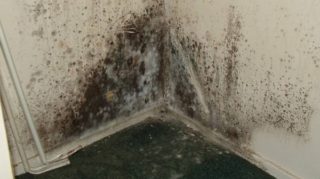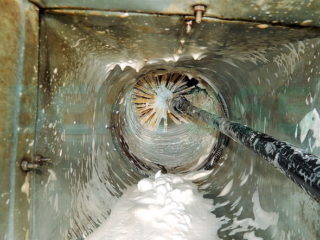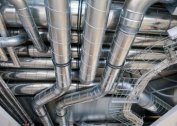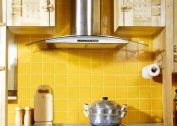Ventilation - one of the utilities, which are necessarily equipped with residential, administrative and utility buildings. Due to air circulation, carbon dioxide, fumes and dust produced by breathing are removed from the rooms. At the same time, a clean atmosphere enters the buildings, which contributes to the creation of a healthy and comfortable microclimate in the rooms. Grids are installed on the supply and exhaust channels. All the pollution that enters and leaves the premises is deposited on them. If the exhaust grilles are not regularly cleaned of dust, unpleasant consequences arise for human health and for interior elements.
Design and purpose of the ventilation system
The ventilation system is designed to provide indoor air exchange. For each of their types, the norms of multiplicity are established - the number of full volume updates in one hour. For living rooms, the multiplicity should correspond to 2-3, kitchens and bathrooms - at least 5, classes and gyms - 3-4. The principle of ventilation is based on the movement of air under the influence of natural or forced draft.
Depending on the installation location, systems can consist of the following elements:
- Supply air holes. They are usually equipped under the ceiling, so that when they go down, the cold air can warm up to the optimum temperature for people.
- Ventilation grates. They carry out air purification from mechanical impurities, dust and insects with filters and mosquito nets. Check valves prevent back draft.
- Fans They are installed in rooms where there is no draft or its strength is insufficient to ensure high-quality air exchange. Devices can be installed on the supply and exhaust openings or immediately on all.
- Overflow grilles. They are installed in the interior doors of living rooms and auxiliary rooms to ensure air circulation when they are in a closed state.
- Channels They are pipes of round or rectangular cross-section. Usually routed from the hood or from the air inlet to the damp rooms.
- Central shaft with upper manifold. It is part of a multi-story building project. Serves to collect and bring out contaminated atmosphere.
All elements of the system should be cleaned regularly. The frequency of cleaning is determined by regulations and the intensity of work of structures.
Mud areas
Since polluted air from the street and the premises passes through the ventilation system, plaque inevitably occurs on all elements of the structures.
Foreign formations occur in such parts of the system:
- Mosquito net. These elements take the brunt of the load. They retain fat, tar, dust, wool and fluff from pets. All this must be removed weekly to avoid clogging the system.
- Propeller blades. During rotation, they capture a large amount of partially purified air and become covered with plaque.
- Channels Pipes have a large area and retain all contaminants that have passed through the pre-filters.
Periodic cleaning of the system is necessary so that soft formations do not harden. Otherwise, removing them will be much more difficult.
Procedure Frequency
The necessity and frequency of servicing ventilation systems is regulated by the Federal Law No. 52 of 03/30/1999 and the Order of the Federal State Institution GSEN Center No. 107 of 08/12/2004. The cleaning procedure is described in more detail in GOST and SanPiN.
Frequency of work:
- monthly - kitchens, canteens, production associated with a large volume of dust, fat and oil fumes;
- quarterly - schools, kindergartens, gyms, hospitals and clinics;
- annually - residential buildings and apartments, administrative, household buildings and structures.
Ventilation ducts from technological equipment must be cleaned as they become contaminated, not focusing on the established time. In particularly dirty plants, system elements need to be cleaned every week.
The importance of timely care
Many property owners and company leaders underestimate the importance of regular maintenance of ventilation systems, considering them to be excess interior and useless construction.
Ignoring sanitary standards leads to the following consequences:
- Due to contamination of structural elements, it is first limited, and then the flow of fresh air stops. The concentration of carbon dioxide in the room increases, which causes fatigue, headache, reduces immunity and increases the risk of diseases.
- Stagnation of air contributes to the formation of moisture and dampness. In some cases, condensation appears on the surface. This negatively affects furniture, things and interior decoration. Lack of air exchange can cause costly repairs.
- Pollution is a breeding ground for viruses and bacteria. Pathogens provoke many diseases in indoor people, animals and plants.
- Dust is combustible. A random spark can cause it to ignite, followed by the spread of fire in the rooms.
In accordance with regulatory enactments, a manager of any rank must take effective measures to maintain the ventilation system in working condition.
Contamination removal methods
To clean the ventilation elements of dirt, improvised and professional tools are used. The choice is determined by their location and scope of work. Residents of apartments can only clean communications and equipment within the boundaries of their property. Maintenance of public facilities is the prerogative of special sanitary services.
To clean clogged channels and grilles, the following methods can be used:
- Mechanical. It is a scraping of deposits using a manual or electric brush. A backlight camcorder can be used to work in remote areas. The cleaned material is either carried away by the air stream into the mine or collected by an industrial vacuum cleaner.
- Chemical. It is used to remove grease and oil deposits that cannot be removed with a brush. This approach is used in the kitchens of apartments and catering. A special liquid is sprayed onto the elements of the system, which dissolves plaque. Then it is sucked in by a vacuum device or, under the influence of traction, flows into a common vertical channel.
- Cryogenic. Impact on pollution is carried out by spraying granules of dry ice. In contact with plaque, it instantly freezes and explodes, which leads to peeling from the base. Upon subsequent heating, they turn into slurry, which is sucked in by a vacuum cleaner or drains into the central shaft.
To consolidate the achieved result, disinfection can be carried out. Its purpose is to destroy pathogens that could remain in the system after processing.
Equipment for cleaning exhaust ventilation grilles
Exhaust ventilation grilles are cleaned of dust with a soft toothbrush. If fat adheres to them, you can wash the items in a soapy solution. It is advisable to remove the fans from the sockets, disassemble and wipe with a damp sponge. The channels are cleaned with hand spray guns or garden sprayers with a long handle. The remaining moisture is collected by rags wound on a stick or telescopic fishing rod.
Mechanical cleaning is best done using a chimney sweep ruff on a cable, flexible shaft or sliding handle. If system maintenance needs to be carried out frequently, it is advisable to purchase an electric brush with a rotation function.







